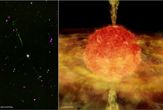Cannibal Star Gobbles Up Companion and Starts Acting Younger

This story was updated at 2:37 p.m. EDT.
Space can be a pretty rough place, and it just got rougher. A study has found evidence of a "cannibal star" that recently devoured a companion star or planet, possibly spawning a second generation of exoplanets in the process.
Data from NASA's Chandra X-ray Observatory showed that the star, called BP Piscium (BP Psc), is a more-evolved version of our sun, but with a surrounding disk of dust and gas usually associated with young stars.
Such disks are thought to give rise to planets. Because BP Psc is relatively aged, the disk is somewhat of a mystery. [Image of the cannibal star]
Optical data also revealed a pair of jets, several light-years long, extending from the poles of the star and shooting material at high velocities out of the system in opposite directions. These jets, too, are typical of a very young star.
Normally, a young star grows bigger as debris from the surrounding disk falls onto it. The star incorporates about 90 percent of the dusty, gaseous material and recycles the remainder through its jets.
Not what it seems
Sign up for the Live Science daily newsletter now
Get the world’s most fascinating discoveries delivered straight to your inbox.
To explain the presence of young-star features on the elderly star, scientists suggested that BP Psc appropriated the disk and jets from a younger neighbor that it gobbled up.
"It appears that BP Psc represents a star-eat-star universe, or maybe a star-eat-planet one," said the study's leader, Joel Kastner, a professor at the Rochester Institute of Technology. "Either way, it just shows it's not always friendly out there."
BP Psc is located about 1,000 light-years from Earth, in the constellation Pisces. The star, including its disk and jets, is about two light-years wide.
Piecing it all together
The disk and jets may disguise BP Psc's true age, but other characteristics of the star are giveaways. Most young stars form in clusters. BP Psc, by contrast, is isolated and not located near any star-forming cloud. Furthermore, its surface gravity appears to be weaker than would be expected for a young star. And its atmosphere contains only a small amount of lithium, as do the atmospheres of most elderly stars.
Chandra's X-ray eyes provided additional evidence. Young, low-mass stars are brighter than most other stars in the X-ray spectrum, and Chandra's examination of BP Psc revealed that its X-rays are too low to be from a young star. The detected X-ray emission rate is more consistent with those of rapidly rotating giant stars.
"It seems that BP Psc has been energized by its meal," said study co-author Rodolfo Montez Jr., also from the Rochester Institute of Technology.
Unmasking BP Psc
BP Psc is not too different from what scientists expect of our sun toward the end of its life. When the sun becomes a red giant star like BP Psc, it will swell so much that it may even consume Earth.
"BP Psc shows us that stars like our sun may live quietly for billions of years, but when they go, they just might take a star or planet or two with them," said study co-author David Rodriguez, from UCLA.
At the moment, the researchers are unsure whether it was a companion star or a planet that BP Psc gobbled.
"It could be a small star or a large planet," Kastner said. "We don’t know which it could be, but we’re very interested in finding out."
Not all is lost
Even if BP Psc is killing off some of its planets, it also could be spawning replacements, evidence suggests.
A second round of exoplanets may be growing from the star's disk, hundreds of millions of years after the first round of planetary formation, scientists say.
A separate study that used observations from NASA's Spitzer Space Telescope reports possible evidence of a giant planet in BP Psc's orbiting disk. This could be either a newly formed planet or one that was part of the star's original planetary system.
"Exactly how stars might engulf other stars or planets is a hot topic in astrophysics today," Kastner said. "We have many important details that we still need to work out, so objects like BP Psc are really exciting to find."
Studying these so-called cannibal stars could also aid the search for new planets beyond the ones in our own solar system.
"In order to understand the extrasolar planets that are now being discovered by the dozen, we need to figure out how planets might be forming, and therefore where we should go look for them," Kastner saidSPACE.com Staff Writer. "I think this object is especially interesting because it gives us a good shot at finding young planets around an old star."
The results of the study are detailed in a recent issue of The Astrophysical Journal Letters.

Denise Chow was the assistant managing editor at Live Science before moving to NBC News as a science reporter, where she focuses on general science and climate change. Before joining the Live Science team in 2013, she spent two years as a staff writer for Space.com, writing about rocket launches and covering NASA's final three space shuttle missions. A Canadian transplant, Denise has a bachelor's degree from the University of Toronto, and a master's degree in journalism from New York University.











